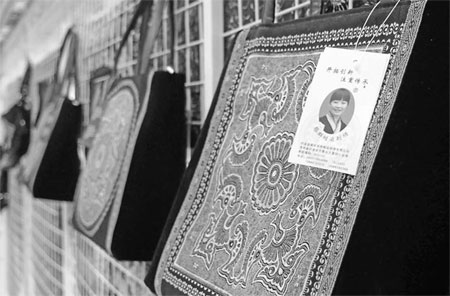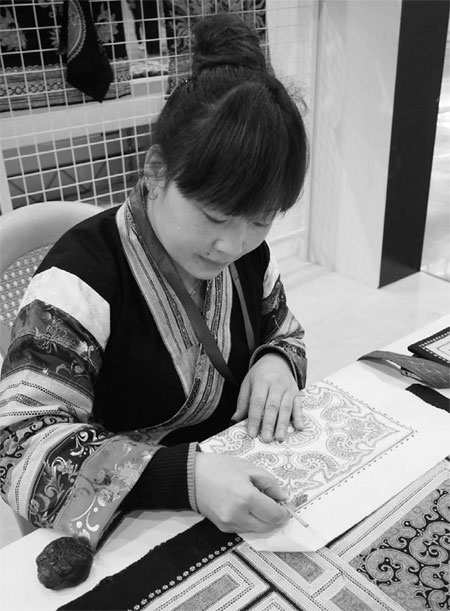Putting folk art skills to work
Updated: 2014-01-01 07:15
By Li Jun and Zhao Kai (China Daily)
|
|||||||||||
The women of Guizhou have turned their traditional batik dyeing and embroidery techniques into a source of income. Li Jun and Zhao Kai report from Guiyang.
Adecade ago, it seemed the best option for young people like Cai Qun from the mountainous areas of Guizhou province was to head to the cities in search of work. However, these days Cai would advise girls to stay in their villages, where there are more employment opportunities than before.
In 2009, Cai set up a small company making goods using the traditional batik and embroidery techniques of the Miao ethnic group. Employing dozens of local women, the company produces handmade goods with intricate designs that sell well overseas, particularly in Singapore and the United States.
When Cai left her village in 2000 at age 20, she never imagined she would end up running such a business. Instead, she was heading to Guiyang, the capital of Guizhou province, where her sister said she had found a job for her.
"But when I got there, I found out her work was collecting garbage at landfills." Cai says she was shocked and very sad.
Having no other options, Cai joined her sister in sorting garbage. "The days were rough. We had to wake up before sunrise to go to dumping sites and we worked until sunset."
After a month, she decided to try her luck elsewhere, heading to Shenzhen, Guangdong province, which was known for its population of migrant workers. But for a village woman with limited skills, the best job Cai could find in Shenzhen was as a waitress in restaurants.
The turning point came in 2006 when she participated in a contest on traditional handicraft skills in her hometown. The contest was aimed at finding new workers to design tourist goods for Guizhou province.
"Though I don't have any other skills, as a woman of the Miao ethnic group, I learned the skills of dyeing and embroidery from elders in my village when I was a little girl," says Cai. "That's basically all I learned in my entire life, so I decided to give the talent fair a try."
Batik is a technique for creating designs on cloth using wax and dye, while embroidery is used to add intricate patterns. In Guizhou province, local people of the Miao and Bouyei groups use these techniques to create images on traditional costumes, including plant and animal images with mythological significance. Because of its high aesthetic value, batik fabrics and artworks are put in display in museums around the world.
During the contest, Cai's brilliant artwork earned her the title of skilled craftsman.
"It's really impressive to see a girl at this young age create such amazing works of art," says Long Chaoya, director of the Small and Medium Enterprises Bureau of Guizhou province.
Long is also the organizer of the 2006 event in which Cai participated - the Colorful Guizhou Tourism Product Original and Craftsmen Competition and Exhibition.
"The event was intended to help people like Cai to present their skills and help them realize their dreams," Long says. Launched in 2006, the competition and exhibition has become a famous annual event for the local cultural industry in Guizhou.
The competition has also attracted foreign folk artists. According to Long, more than 300 craftsmen from more than 60 counties participated this year's event.
A lot of local craftswomen were discovered in the competition. But in Long's mind, the local craftswomen like Cai encountered a common problem: the lack of marketing skills and capital to upgrade the scale of their business.
Therefore, at the initiative of Long, the SME bureau of Guzihou has established a special foundation for training the local women in managerial skills and helping them to start their own businesses.
With the prize money from the competition and the SME bureau, Cai started her own business selling batik artworks. Like any startup, the money did not just turn up automatically. Cai struggled at first, but little by little her artworks gained recognition in the local travel market.
"I didn't realize it was a business opportunity until someone was actually willing to pay for my works at the talent fair," Cai says. "More importantly, it boosted my confidence."
A tourist group from South Asia once visited Cai's workshop and praised her artwork highly. They bought a lot of products at high prices, and shortly after that, the same travel agency placed another order.
Cai was very happy to see her business growing, providing a brighter future for women like her.
"Because it is not only me, but also my sister in Guiyang and the girls in our village that are good at doing this too."
In 2009, with 80,000 yuan ($13,000) of initial funding, Cai and her husband established a company hiring local villagers to make batik and embroidery products.
Right now, Cai's Batik and Embroidery Company hires more than 60 local women during peak season. Prices for their products range from hundreds to thousands of yuan, and the annual output totals around 3 million yuan.
Earlier this year, Cai became a deputy to the National People's Congress.
"I was stunned and excited when I heard I had been elected," Cai says, "Then I realized that it means a lot of responsibilities."
In March this year, she made a proposal at the annual session of NPC on promoting industries rooted in ethnic cultures.
"People have realized the value of ethnic artworks, so ethnic groups should preserve our traditions and pass them on," Cai suggests. "By combining ethnic artworks with tourism, we can protect our traditions and provide more jobs at home to support the young."
Cai has a dream that one day women in her village will no longer need to work outside. "My sisters and I can sit together at home, singing folk songs while making batiks."
Xing Yi contributed to this story.
|
Above: Cai Qun draws pattens for a batik design at her workshop at Dazhai village, Zhijin county in Guizhou province. Below: Cai's workshop showcases batik handicrafts, which are favorites for tourists. Photos by Zeng Jun / for China Daily |

(China Daily 01/01/2014 page5)
Today's Top News
Iran says nuclear deal to be implemented in late Jan
Putin vows to annihilate "terrorists" after bombings
China to promote cultural soft power
Cities go live with air quality updates
Second kid 'easier said than done'
Russian police detain dozens after bombings
Death toll in Russia's bombings rises to 33
Xi's bun shop visit wows media
Hot Topics
Lunar probe , China growth forecasts, Emission rules get tougher, China seen through 'colored lens', International board,
Editor's Picks

|

|

|

|

|

|






